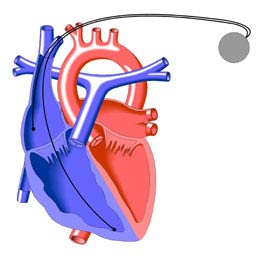
Pacemaker With Leads Into the Heart |
|
Pacemakers
In general, pacemakers are placed to treat heart rates that are too slow or when the heart's atrial pacemaker (sinoatrial node) no longer communicates with the ventricular pacemaker (atrioventricular node). In some cases, pacemakers can detect and treat certain types of fast heart rhythm problems (tachycardia) as well.
An artificial pacemaker is a small electronic device about the size of a half dollar coin that has its own battery. When connected to the heart muscle by a thin wire called a lead, it can detect the heart's rhythm. If the heartbeat is too slow, the pacemaker can send a signal to the heart to make it beat faster.
The type of pacemaker needed is determined by the nature of the rhythm problem and the patient's size. Normally, the wires (leads) are threaded through a large blood vessel without the need of surgery. The pacemaker is usually placed near the left collarbone under the skin.
The procedure or operation to insert the pacemaker is done either in the operating room or in the electrophysiology laboratory under mild sedation (if needed). The incision will be under the left collarbone or in the upper abdomen. In the case of a permanent pacemaker, nothing will be visible outside the body. First the lead or leads are placed in contact with the heart muscle and they are tested to make sure that they will work well. Then the pacemaker is put in place and the whole thing is tested. Once everything is working well the skin incision is closed and the site is bandaged. Recovery from the sedative will take several hours.
The pacemaker can be checked from home by using the telephone to call in the electrocardiogram and pacemaker function. This will be checked in greater detail when the patient goes to the pacemaker clinic. This may involve a chest x-ray (to check the lead) and a detailed pacemaker evaluation.
The pacemaker battery will usually last for years. The exact length of time depends on how much of the time the pacemaker is in use. The batteries last longer if the pacemaker is used only a small part of the time; shorter if the pacemaker makes every beat. Battery life is also determined by how much energy is used to make each heartbeat. When the battery is getting low, the pacemaker gives a signal during the magnet test (part of the calling in process or during the pacemaker check in clinic) or by a change in rate that tells the doctor that the battery is getting low. A battery (generator) change is then scheduled. In general, only the pacemaker generator is changed if the lead is still working well.
Modern microwaves do not affect pacemaker function and analog cellular phones may be used. The patient's cardiologist should be asked about digital phones, however. The activity restrictions that pertain to a patient wearing a pacemaker are mostly determined by the nature of the heart defect and the patient's overall physical condition rather than any limitations of the device. The physician will determine safe levels of exercise on the basis of testing and other factors. Because of the risk of lead fracture (breakage), high impact sports are not recommended, however.
A person with a pacemaker will probably want to wear a bracelet stating the fact. Forms for ordering such a bracelet are available at most pharmacies. Metal detectors may be passed safely. However, if the detector alarms, the security person should be shown the bracelet or information card (provided at the time of implantation) and should not be allowed to place the detector wand directly over the pacemaker. |